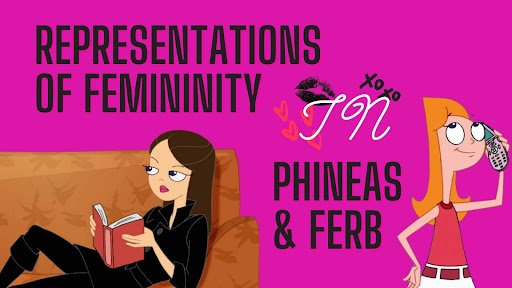Representations of Femininity in Phineas and Ferb
Graphic by Kara Kowalski
Growing up, I loved watching cartoons. From “SpongeBob” to “Arthur,” there was nothing better than sneaking in one more episode before school. At the time, however, I didn’t understand how impactful the media I consumed was in shaping how I viewed the world. Specifically, I was unaware of how it molded my understanding of gender roles and my place as a woman in society. Now, with about 10 years distance from my hardcore cartoon days, I finally am confronted with how important media and cartoons are for young children who are learning about societal standards.
I was recently reminded of this, when I was babysitting two young girls. We were reading a book starring a family of bears. As we read, the two girls pointed out the different characters and assigned them the titles of “mom,” “dad,” and “baby.” Unsurprisingly, the bear wearing a dress was destined to be called mom, no matter what. I found this specifically odd considering that their mother rarely wore dresses, often opting for pants instead. When I asked why this character must be the mom, one girl replied, “because she is wearing a dress.” This experience made me think both about how gender is signaled to children and how they internalize gender through the media they consume. As a major source of socialization, media then goes on to drastically impact children’s worldviews.
Children’s cartoons can leave a lasting impact on children's impressions of gender norms based on how the female characters are portrayed. Children’s cartoons in particular are interesting because the characters often wear the same signature outfit or have catchphrases to make them easily recognizable to young audiences. In Phineas and Ferb, the 2007 Disney cartoon following the outlandish projects and activities Phineas and Ferb do over summer vacation, the two main female characters, Candace and Vanessa, in their strong desire to dismantle the plans of the male characters, represent femininity in opposition to creativity and freedom.
Candace’s signature look conforms to stereotypical conceptions of femininity. She wears a pink top, white skirt, and long hair. The choice of pink and the silhouette of the skirt follow stereotypical conceptions of what women and young girls should wear and what they should look like. Candace’s appearance adheres to typical depictions of femininity, associating her character with “girliness” Looking at her clothing in combination with her actions ties her obsession with busting her brothers and her inability to do anything for herself with a negative view of femininity.
Candace’s main desire in the show is to dismantle her younger brothers’ plans by exposing them to their mother. As a result, her main catchphrase is a long, drawn out “MOOOOM” followed by a retelling of Phineas and Ferb’s antics. First, the shrill tone of the catchphrase paints Candace as annoying and obnoxious. The catchphrase also highlights how, instead of pursuing her own activities and hobbies, her entire focus is on being an obstacle to her brothers. For example, in the first episode of the show, Phineas and Ferb build a roller coaster in their backyard. Instead of enjoying the roller coaster and having fun, like the other kids, Candace runs around, trying to lure her mom into the backyard to bust her brothers. The rest of the show follows the same arc in each episode: Phineas and Ferb exercising their creativity and genius, and Candace frantically trying to dismantle their plans. Candace, in her pink outfit and “girly” exterior, is constantly placed as the antithesis of fun and freedom. She represents the trope of women who are stubborn and unwilling to let go. Notably, Candace does not have a clear reason for her desire to “bust” her brothers, which further leads viewers to believe her to be unhinged and irrational. This characterization of Candace is directly in contrast with the calm and easygoing nature of her brothers, who are both portrayed as very intelligent and levelheaded. Despite Candace’s efforts to “bust” them, Phineas and Ferb are not angry with her and even invite her to join in on their fun. Arguably, her only goal outside of stifling her brothers’ plans is to date Jeremy. Still, even that goal is defined by a male character. The combination of Candace’s continued and unrelenting attempts to control her brothers, and her signature pink outfit, creates an image of femininity as not having individual desires and goals and as being based on an effusive and neurotic need to control others. This image of femininity is damaging and limiting in its representation of the role of women in society.
Vanessa is Candace’s darker and moodier foil in the show. Unlike Candace’s bright pink facade and “girly” exterior, Vanessa sports a fitted, all-black ensemble. Her personality resembles the trope of a “femme fatale” rather than a “girly girl.” However, even so, she is still subject to the same restrictive gender norms as Candace, presenting the same problematic idea that women are defined in opposition to men and do not have desires of their own.
While Candace is neurotic and unhinged, Vanessa is often detached and unaffected. She is the epitome of the cool teenager who doesn’t care about anything. This characterization is highlighted through her catchphrase: “Whatever.” Vanessa comes off as cool in her dismissal of stereotypically female attire. For instance, when Vanessa and Candace swap clothes as a result of a mix up at the drycleaners, Vanessa laments over her appearance in Candace’s clothing. In many ways, I see Vanessa as embodying the current idea of being “not like the other girls.” Vanessa presents a very different idea of femininity than Candace. However, even though Vanessa rejects stereotypically girly activities and colors, she is still subject to the same biases placed against women like Candace.
Despite Vanessa’s clear differences from Candace, she is also obsessed with foiling the plans of a male figure in her life: her father. In the iconic song, “Busted,” both Candace and Vanessa are obsessed with being right and enforcing order. They characterize themselves as disciplinary figures when they sing “There's a new cop on the beat.” Further, they also expose how they are viewed as creating drama when they sing “she says it's all just drama.” A significant similarity between Candace and Vanessa is that both of their moms do not believe them. Instead, their moms view them as being dramatic and silly. They are both dismissed and belittled by female figures who arguably should support them, feeding into the image of irrational hatred between women, and enforcing the idea that women should not be listened to or trusted.
Instead of having their own skills and desire, Candace and Vanessa are almost entirely based in their opposition to male characters. This image of femininity as an embodiment of imposing structure at the expense of fun and creativity imparts the message that women, whether or not they adhere to stereotypical depictions of femininity, are not individuals with a full expression of agency. This presentation of femininity has the potential to negatively impact young female viewers by promoting a stereotypically negative view of femininity. I hope that in the future children’s media can challenge gender norms and stereotypes while maintaining an environment of exploration and fun. In the immediate future, with the girls I babysit and beyond, I’m excited to continue having conversations about gender and how it operates as a cultural construct.

